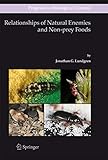Relationships of Natural Enemies and Non-Prey Foods / by Jonathan G. Lundgren.
Tipo de material: TextoSeries Progress in Biological Control ; 7Editor: Dordrecht : Springer Netherlands, 2009Descripción: recurso en líneaTipo de contenido:
TextoSeries Progress in Biological Control ; 7Editor: Dordrecht : Springer Netherlands, 2009Descripción: recurso en líneaTipo de contenido: - texto
- computadora
- recurso en línea
- 9781402092350
- QL360-599.82
Springer eBooks
Glucophagy -- The Functions of Non-Prey Foods in the Diets of Entomophagous Species -- The Sugar Feeders -- Floral Nectar -- Extrafloral Nectar -- Honeydew -- Pollinivory -- The Pollen Feeders -- Adaptations to Pollen feeding -- Pollen Nutrition and Defense -- Granivory -- The Seed Feeders -- Adaptations to Granivory -- Seed Nutrition and Defense -- Seed-Associated Food Bodies -- Seed Preferences of Natural Enemies -- Fungi and Microorganisms -- Mycophagy -- Symbioses with Microorganisms -- Applied Aspects of Non-Prey Foods for Natural Enemies -- Non-Prey Foods and Biological Control of Arthropods -- Plant-Incorporated Pest Resistance and Natural Enemies -- Biological Control of Weed Seeds in Agriculture Using Omnivorous Insects -- Conclusions and the Relative Quality of Non-Prey Foods for Natural Enemies.
There are very few natural enemies so maladapted as to rely on prey as their sole nutritional resource. The importance of non-prey sources of nutrition have received disproportionately less attention than prey when one considers how important non-prey foods are to the evolution and ecology of natural enemies. This book examines the intricate and diverse interactions between non-prey foods and natural enemies from both parties’ perspectives, beginning at an organismal level and taking the reader on a journey that illustrates how these interactions are inextricably tied to the outcome of biological control programs targeting insects and weed seeds.
Para consulta fuera de la UANL se requiere clave de acceso remoto.


